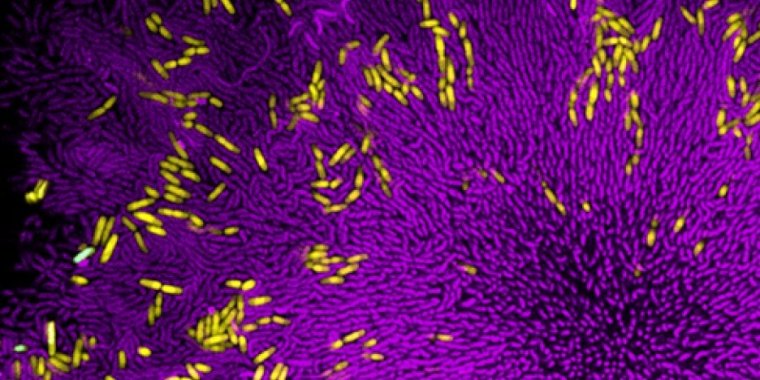| News / Science News |
Harmful bacteria can elude predators when in mixed colonies
Efforts to fight disease-causing bacteria by harnessing their natural predators could be undermined when multiple species occupy the same space, according to a study by Dartmouth College researchers.

Colonies of the bacterium V. cholerae (purple) insulate E. coli (yellow) from its natural predator. Photo: James Winans
When growing in mixed colonies, some harmful bacteria may be able to withstand attacks from the bacteria and viruses that target them by finding protection inside groups of rival species.
The researchers found that the intestinal bacterium Escherichia coli became surrounded by tightly packed colonies of Vibrio cholerae — which causes the deadly disease cholera — when the species were grown together.
The clusters protected E. coli from Bdellovibrio bacteriovorus, a bacterium that preys on both species but in the study only killed the outer layer of V. cholerae. The E. coli bacteria were protected and went on to multiply.
The findings add a new layer of complication to the development of biological antimicrobials, in which bacteria-killing bacteria or viruses — known as bacteriophages — are deployed to fight infections, said corresponding author Carey Nadell at Dartmouth.
These organisms can be more effective than antibiotics at penetrating bacterial colonies, or biofilms, and have emerged as a possible supplement or alternative to antibiotics. Bacteria worldwide have become more resistant to antibiotics due to the drugs' overuse.
The study shows that interactions among multiple bacterial species can be difficult to predict from studying species in isolation.
"There were elements of our experiments that are close to real life — a lot of infections are caused by bacteria living with other bacteria in a biofilm," Nadell said. "They're like a forest — they're little ecosystems.
"Our research shows that the way prey populations can resist or not resist predators can be very different in multispecies conditions. The efficacy of bacteriophages and predatory bacteria in killing harmful bacteria might depend on the other species their prey live with and on the biofilm structures they produce alone versus together." (U.S. National Science Foundation)
YOU MAY ALSO LIKE





